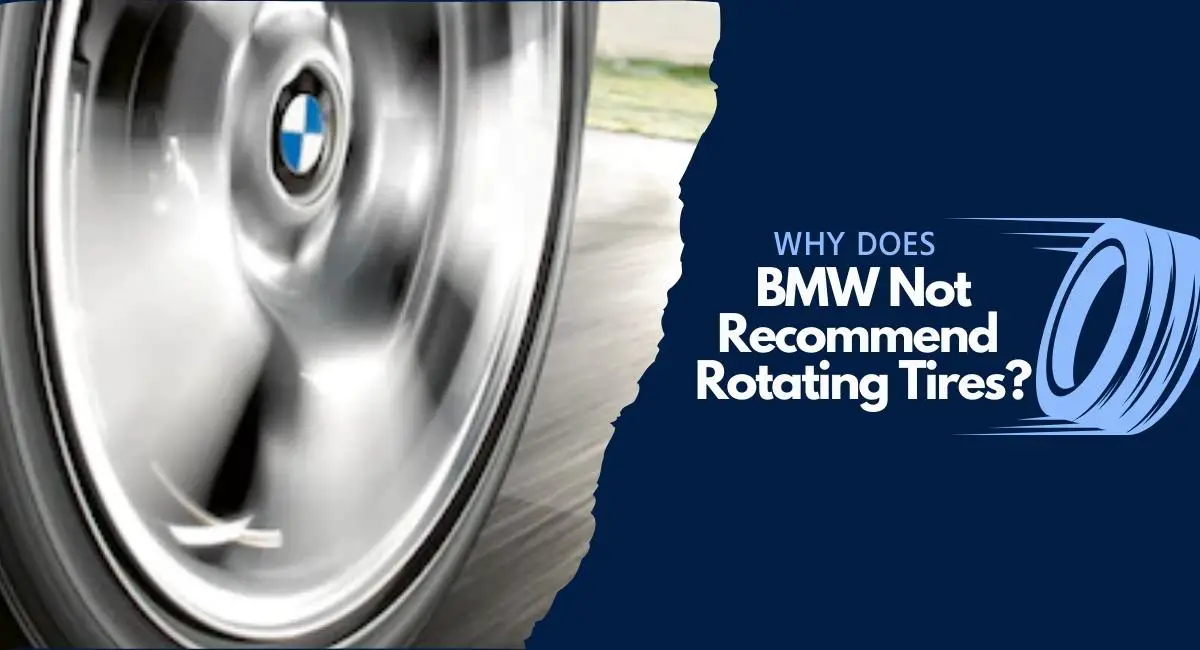BMW has long been synonymous with performance, luxury, and engineering excellence. For BMW owners, the driving experience is not just about getting from point A to point B; it’s about the thrill of the journey and the connection between driver and machine.
One aspect of this driving experience that often sparks debate is tire maintenance, specifically, the practice of tire rotation. BMW does not recommend tire rotation because it is a cause for safety concerns. They have a unique commitment to performance and have a dynamic wheel alignment.
In this article, we’ll discuss the following topics to make you understand the intricacies of BMW tire rotation:
- Why BMW does not recommend rotating tires,
- The Mechanics take on car tire rotation and when you should do it
- The philosophy behind BMW’s unique tire rotation pattern and
- Whether there are exceptions to their guidance.
But first,
What is a Tire Rotation?
Tire rotation is a regular maintenance practice involving repositioning a vehicle’s tires from one wheel position to another. The primary goal of tire rotation is to ensure even tire wear across all four tires, which can extend their lifespan and maintain optimal performance. Uneven tire wear can occur due to vehicle weight distribution, alignment issues, driving habits, and road conditions.
Mechanics move tires following specific patterns or sequences during a tire rotation. The most common rotation patterns include:
Front-to-Rear Rotation: In this basic rotation pattern, the mechanic moves the front tires to the rear axle and the rear tires to the front axle. It helps balance wear between the front and rear tires.
Cross Rotation (X-Pattern): This pattern involves crossing the tires diagonally. The front left tire moves to the rear proper position, and the front right tire moves to the back left position. This rotation can help mitigate uneven wear due to cornering forces.
Directional Tire Rotation: Directional tires have a specific tread pattern designed to rotate in one direction for optimal performance. They are moved from front to rear on the same side of the vehicle to rotate directional tires, maintaining their original rotation direction.
Staggered Tire Rotation: Some performance or sports cars have different tire sizes on the front and rear axles (a staggered setup). In such cases, tire rotation is limited to front-to-rear movements on the same axle.
The tire rotation frequency depends on various factors, including the vehicle’s make and model, tire type, driving conditions, and manufacturer recommendations. It is vital to consult the vehicle’s owner’s manual or follow the automaker’s guidelines for the appropriate rotation interval.
However, car brands like BMW have a different take on tire rotation and do not recommend it, as explained below:

Why Does BMW Not Recommend Rotating Tires?
When it comes to tire rotation, some tire manufacturers recommend you change tires every 500,000 miles, while some advise against it. For instance, BMW takes a distinctive approach that differs from many other automakers. It’s crucial to explore the factors influencing BMW’s decision not to recommend tire rotation to understand this stance:
1. Precision Engineering
BMW vehicles are renowned for their precise handling and performance. These characteristics are not accidental; they result from meticulous engineering, including the car’s tire specifications and alignment. Deviating from these specifications through tire rotation could affect the finely-tuned handling dynamics.
2. Rear-Wheel Drive (RWD) and All-Wheel Drive (AWD) Dynamics
Most BMWs are either rear-wheel drive or all-wheel drive. These configurations inherently create different wear patterns between front and rear tires due to variations in power distribution and vehicle dynamics. BMW engineers account for these differences in their tire specifications, making rotation less necessary for wear equalization.
3. Performance Optimization
BMW enthusiasts appreciate the brand’s commitment to performance. The tire setup and alignment calibration aim to achieve the desired ride and handling characteristics. Tire rotation could disrupt this balance, potentially compromising the unique driving experience that BMW owners cherish.
4. Warranty and Liability Concerns
Manufacturers are also concerned about potential warranty claims and liability issues if you do not follow tire rotation recommendations. Deviating from manufacturer guidelines may provide grounds for denying warranty coverage in case of tire-related problems or accidents.
5. High Cost
Handling or servicing BMW cars is costly. Removing your BMW tires could cost up to $125 an hour. So why would you add this cost to your car servicing when you can evade it? And if something goes wrong when you’re car rotating, you might not have the coverage of a warranty. With BMW car tires, once you rotate them, you’ll need it done every 3,000 miles, reducing any economic advantage.
In essence, BMW’s decision not to recommend tire rotation is rooted in its pursuit of delivering an uncompromised driving experience, aligning with its precision engineering, and mitigating potential warranty and liability concerns.
What is Other Mechanics’ take on Car Tire Rotation?
While tire rotation is a common practice in vehicle maintenance, the approach and opinions of mechanics may vary based on their experiences, expertise, and the types of vehicles they work on. Here are some additional perspectives and insights from mechanics regarding car tire rotation:
According to some mechanics, tire rotation is of marginal value in terms of saving money because the cost of tire rotation roughly equals the amount you save by extending your tire life.
Besides, when you consider tire rotation for your BMW, you’re creating a chance for other car services like engine flushes and fuzzy-dice reupholstering, which can be costly.
Nevertheless, many mechanics emphasize the importance of regular tire rotation to ensure even wear. They argue that uneven wear can lead to premature tire replacement, which can be costly for vehicle owners. Mechanics often recommend following the manufacturer’s rotation guidelines to maintain tire performance and longevity.
While the core concept of tire rotation remains consistent, mechanics may have nuanced approaches and recommendations based on various factors, including the vehicle’s make and model, tire type, and owner preferences. Vehicle owners must consult with qualified mechanics and follow their guidance to maintain optimal tire performance and safety.
Understanding the BMW Tire Rotation Pattern
While BMW discourages traditional tire rotation, it doesn’t mean they ignore tire maintenance altogether. Instead, they advocate for a unique tire rotation pattern tailored to their vehicles:
- Front-to-Rear Only: BMW suggests that if tire rotation is necessary, it should be limited to moving the front tires to the rear and vice versa. The key is that the tires should maintain their original front or rear axle positions. This approach aims to minimize any disruption to the vehicle’s handling dynamics.
- Monitoring Tire Wear: BMW places significant importance on monitoring tire wear and replacing tires as needed. Regular visual inspections and routine maintenance are essential to ensure that tires remain in good condition, and replacement is when they end their useful life.
- Balancing and Alignment: BMW owners must maintain proper wheel alignment and tire balance. It helps preserve the intended driving experience and ensures that the tires wear evenly to the extent possible.
Are There Exceptions to BMW’s Guidance?
As BMW’s stance on tire rotation is clear, there may be exceptions where tire rotation could still be beneficial for BMW owners:
1. Irregular Tire Wear: If you notice signs of uneven tire wear, such as vibration, noise, or decreased traction, it may be wise to consider limited tire rotation. However, even in such cases, adhering to the front-to-rear rotation pattern is generally recommended to minimize potential handling imbalances.
2. Mixed Tire Types: Some BMW owners opt for a combination of summer and winter tires. In such cases, rotating the appropriate tires based on the season may help extend the entire set’s life.
3. Consult with a BMW-Certified Technician: If you have doubts or concerns about your BMW’s tire maintenance, it’s always a good idea to consult a BMW-certified technician. They can provide tailored advice based on your specific vehicle and driving habits.
When You Should Rotate Your BMW Car Tires
Now, rotating BMW car tires is costly, and you need the service, so what should you do? We have a free offer that is not guaranteed but might help. The following cases may get you lucky:
- When your BMW is getting the brakes serviced, and the wheels are off the car, your mechanic can be friendly enough to put them on different wheels at no cost.
- Also, you can get a free tire rotation service when the car gets fixed, and the mechanic forgets and mixes up the tires.
Important Read: Transmission Fluid vs Brake Fluid: Key Differences
Conclusion
Tire maintenance is a critical aspect of vehicle ownership, and BMW’s approach to tire rotation is a testament to its commitment to delivering an exceptional driving experience. While BMW discourages traditional vehicle tire rotation, it’s not a one-size-fits-all rule. The decision to rotate or not rotate your BMW’s tires should be guided by a thorough understanding of your vehicle’s unique characteristics, driving habits, and the specific wear patterns you observe.
